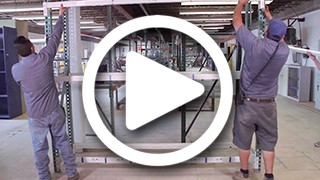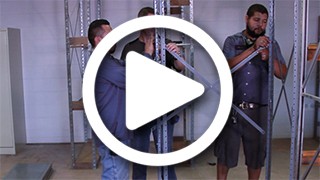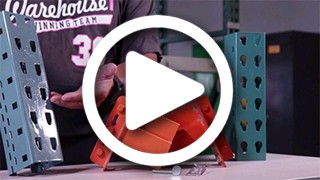The 12 Best Ways to Improve Warehouse Efficiency
Think about your warehouse for a second – how does it run? Is it smooth? Is it efficient? Can there be improvements? There are many ways a warehouse can increase efficiency: the ratio of work done to the amount of time and energy invested. Or in warehouse standards, how fast and effortless can inventory be moved off the shelf and into a customer’s hands?
In some cases, productivity can be the difference between a profit and a loss. Companies will often believe that if their product rolls out on time warehouse efficiency of operations needs no more investment – but product can be moved faster, and customers can be happier. In the long run, this will help you gain more business and stay competitive. If there is money to be made, productivity CAN be increased.
In this article, we will be covering the following ideas to improve your warehouse efficiency:
- Take advantage of cubic space
- Set up performance metrics
- Build a warehouse inside your warehouse
- Streamline receiving
- Adopt warehouse technology
- Evaluate storage solutions
- Maintain equipment
- Use louvered hanging systems
- Optimize containerization
- Measure and analyze performance
- Cross-train employees
- Never stop improving
How to Improve Warehouse Efficiency
1. Take advantage of cubic space
A big mistake in warehouse optimization is not sufficiently using all available cubic space. Studies have shown the cost of space and utilities ranges from 25 to 30 percent of the cost per order. Inefficient use of cubic space leads to an increased cost for additional space you don’t need. Make sure to utilize all available vertical space with pallet racking, mezzanines, and multi-level order picking concepts. Be sure you know how to properly organize your warehouse as well.
2. Set up performance metrics
Key Performance Indicators (KPIs) are used in general business to evaluate success. Warehousing KPIs usually focus on external performance factors that impact customers directly, such as one-on-one shipments. This is a good measure, but we can make it more specific. For example, the receiving department has critical measures like cost per line item received, truck time at the dock, volume per man hour, and accurate receipts.
The simple act of measuring and reporting results to your employees will yield improvement: most employees just want to know their performance. Setting a bar then telling them how to reach it will improve productivity.
3. Build a warehouse inside your warehouse
Every warehouse wants to cut down order fulfillment time. One way to do this is to build a warehouse…inside your warehouse.
What this entails is grouping together your most popular inventory to make it easily accessible within the fulfillment center. You can increase efficiency by grouping together 20 percent of your SKUs that make up 80 percent of your orders, reducing travel time for your pickers.
4. Streamline receiving
The receiving area in a warehouse is often frantic. Employees from varying departments as well as delivery people may pass through this section of the warehouse. Create a system to organize the flow of traffic and devote plenty of room for receiving. Cluttered and disorganized conditions can lead to errors.
Image from www.aalhysterforklifts.com.
Many warehouses are using RFID technology, which is used to automatically identify and track tags on products. This is a very cost-effective way to track items.
A great method for receiving is cross-decking. This is a procedure where your items are distributed to a customer chain with low handling and storage time. According to Adaptalift Group, the name cross-docking explains the process of getting products through the inbound dock and transferring them across the dock to an outbound transportation dock.
5. Adopt warehouse technology
These days there are many types of technology that can help you improve your warehouse operations. Consider software to help with forecasting demand when it comes to your inventory management, use a pick-to-light system to help your pickers find products quickly, and use barcode scanners for inventory accuracy.
A warehouse management system (WMS) is a software application designed to support warehouse and distribution management and staff. A WMS can improve warehouse efficiency by suggesting the routes and methods for order picking and put-away. The management software can provide an automated pick list that can be sent to mobile devices. This helps eliminate mistakes and cut down on time and paper use.
6. Evaluate storage solutions
An effective storage solution is the basis of all work that takes place in a warehouse facility. If employees must wander aisles or search through bins for a product, it really takes up time. Implement a storage system that works for the goods you move frequently.
Optimize your storage solutions. Good storage supplies do not necessarily make a warehouse more efficient. They need to be organized. Evaluate your product flow and warehouse traffic to improve how your product is transferred, stored, and retrieved. Make the necessary adjustments.
Color-coded bins are your friend. If all supply rooms in your facility are set up and color-coded the same, it will be much easier for staff to find parts and supplies in your storage bins, and MUCH faster.
A color-coded system can be created using different bin colors or different colored labels on the front of your stackable plastic bins. Check out this color-coding chart or create your own!
7. Maintain equipment
Replace your equipment that doesn’t yield the correct results and be sure to maintain working equipment with standardized procedures. A down forklift, conveyor belt, or other machinery can halt warehousing flow for many hours – creating preventable downtime. And don't forget about your equipment safety.
8. Use louvered hanging systems
Louvered panel systems are a great complement to your stackable plastic bins for high-density storage or point-of-use workstations. These panels and racks give you even more options to help organize your work and storage spaces as well as improve efficiency.
- Wall-mounted units: These flat panels are available in many sizes and can be fastened to walls to keep items together and off the floor.
- Floor standing models: Single-sided, double-sided and mobile units are available.
- Bench-top models: These racks are used on worktables to keep parts within easy reach.
Louvered panels allow a more finished look to your storage areas, while providing strength and durability. Setup and installation of louvered panels are quick and easy.
9. Optimize containerization
Instead of having many different shipping container options on hand, narrow the choices down to two or three, and use an alternative solution for irregular product needs. A limited choice eliminates the time employees may spend trying to find the right sized container for the job.
10. Measure and analyze performance
Take the time to report on daily performance and run analytics to find bottlenecks and areas that can be improved. Keeping track of daily workflow offers a unique perspective on monthly, quarterly, and yearly performance. Then use the data to make changes. You can also offer employee incentives for meeting or exceeding typical daily warehouse productivity measurements.
11. Cross-train employees
Employees who are trained in more than one job can fill in for other workers during busy times or for absentees. Keep your warehouse operations running by encouraging workers to learn new skills on the job.
12. Never stop improving
Remember, an efficient warehouse will mean an effective one. And it will mean happier customers. Never stop improving - always look for new technology to make orders and labeling easier, always keep up with your organization techniques, keep cross-training and advancing your employees, and you will have a very efficient warehouse.
To get the most efficient warehouse you can, be sure to call us about our remodeling services. We can help you maximize your warehouse space. To see our wide selection of products and services that will help your efficiency, go to the Warehouse1 store.



